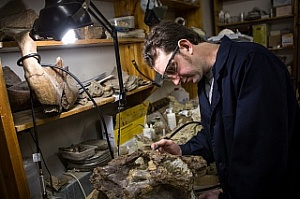Researchers at TSU, Saint Petersburg State University and the Zoological Institute of the Russian Academy of Sciences have identified a new taxon in the family titanozavrid - four-legged herbivorous dinosaurs. The remains of this giant animal were found in Shestakovo village (Kemerovo Region) in 2008. In a comparative analysis, it was found that titanosaur found by TSU paleontologists has structural features that distinguish it from all other members of this group.
- Initially, it was clear only that the remains in front of us belong to a very large herbivorous dinosaur, - says Stepan Ivantsov, employee of the Laboratory of the Mesozoic and Cenozoic continental ecosystem. - Because the unique pieces were made in blocks of sandstone, we spent a few years on their removal from the cemented rock. Together with scientists from the Zoological Institute RAS, we conducted a comparative analysis of remnants with titanosaurs found in other countries.
As a result, it was found that the herbivorous dinosaurs, inhabiting the territory of modern Western Siberia in the Early Cretaceous period (about 100 million years ago), belongs to the suborder sauropod, but it is a representative of a new species. Its length was about 20 meters long and weighs about 50 tons. The new dinosaur is different from fellows by structural features. It has a sacral ribs arranged in a star shape and converges toward the center, there is no articulation of the vertebra in the neural arch. Ancient dinosaurs with such the structure of the skeleton have not found yet in any country in the world.
It should be added that at the moment TSU scientists are finishing work on the description of its findings, the result of which it will be given the Latin name of the open taxon. Now paleontologists are collecting available fragments of dinosaur together. The largest bones, which had once been the sacrum of a titanosaur is already connected. In addition, the part of the blade of a dinosaur and the cervical vertebrae are mounted from multiple pieces. Also the foot of sauropod, which was discovered in 1995, stored in the TSU Paleontological Museum. With high probability, it belonged to the same dinosaur species.
Scientists believe that the unique exhibit should be in the place of permanent free access so that more people could see it. Already this year, paleontologists propose applying the most intact part of the dinosaur on the second floor of the TSU main building.

